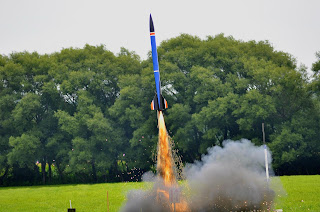At the start of summer, I began buying the motors to be flown this year. This picture shows an unassembled L900 Dark Matter, an L935 Imax, and an L1410 Skidmark. I've never had so much propellant at once...now it's all burned.
Flight 14: 6/23/13, Potter, NY, URRF
This was the first flight of the season, and it was a nice one. I chose the 54mm L935 Imax motor from CTI. At 3147 Newton-seconds of total impulse, this is among the most powerful 54mm motors made. It was a nice, loud flight into clear blue skies at the first annual Upstate Research Rocket Festival (URRF). The altitude was 4282 feet and the speed was about 390 mph. I do not have any pictures or videos for this flight.
Flight 15: 7/6/2013, Potter, NY
For this flight I chose the largest "sparky" motor that will fit into my 75mm motor hardware. The motor is the CTI L1410 Skidmark. It is nearly a full L motor, containing 4828 Newton-seconds of total impulse. The sparky propellants have chunks of titanium mixed into the propellant that cause a tremendous shower of sparks and a deep grumbling roar during burn. They are inefficient, but the coolness factor still makes them very worth flying.
For this flight I flew with the camera bay attached. It reached an altitude of 6512 feet and a top speed of 519 mph. The launch was almost perfect. For some reason that I still have not figured out, the camera switched off at apogee and the camera bay bulkhead was slightly damaged. No damage occurred to the regular parts of the rocket however. Clare took a nice video of the boost and that video can be seen here:
GROUND VIDEO, BOOST
The (partial) onboard video is here:
ONBOARD VIDEO TO APOGEE
I took some recovery pictures. It was amazingly convenient to be able to drive almost right to the rocket. It was also convenient that it missed the trees (by only about 100 feet).
For flight 16, I chose a smaller motor because the field isn't as large as in Potter. I figured if it's not going to go very high or fast, I may as well get the cool factor with another Skidmark. I chose the 54mm K815 Skidmark from Cesaroni. This motor has a total impulse of 2304 Newton-seconds and is nearly the weakest motor I have flown in Positive Ascent. That being said, the result was an incredibly loud and dramatic launch. The flight reached 2662 feet and about 290 mph. It looked like it was going to be another perfect flight.
However, when the main charge fired and the main began opening up, the shock cord flew through the main and folded it over on itself. It was clear right away that it wan't going to free itself. The 36" pilot chute remained open so and provided enough drag so that the rocket landed in its usual order (booster, forward airframe, nose cone) but it landed very hard (I later used the data recorded from the Stratologger altimeter to reveal that it hit at about 46 feet per second, or 31 mph). The booster actually bounced into the air and tumbled after it hit. I was fairly sure there was going to be some kind of damage. However, I was more than pleased when we arrived at the rocket and there was no damage to be found whatsoever. (it barely even got dirty because the field in Geneseo is grass instead of the muck like in Potter) It's mishaps like that that make me glad I overbuilt the rocket.
Clare took a couple pictures of the tangled up main parachute.
After recovery of the rocket, I was pleasantly surprised when another club member (Jim DePape) approached me and showed me a few pictures he took of the liftoff. He emailed me the following 3 pictures. (Thanks Jim)
Flight 17: 8/3/2013, Potter, NY, Annual Family Picnic Launch
For this flight, I chose an L900 Dark Matter motor. This is a 75mm 4 grain motor with a total impulse of 3868 Newton-seconds. It is an Aerotech motor (not CTI) so I had to borrow the motor hardware from Ken Allen for the flight. (Thanks Ken)
The Dark Matter propellant is a different type of sparky. It has a more dense concentration of sparks and darker smoke than the CTI Skidmarks. This is a low thrust and longer burn motor (about 5 seconds) so it made for a slow and graceful flight. It reached an altitude of 4582 and a top speed of 383 mph. It was a perfect flight, and it landed nice and close to the pad which made for a short and easy recovery.
In an effort to avoid the main parachute tangling problem I tried "free bagging" the deployment bag. This technique allows the nose cone to drift down on the pilot chute after the pilot pulls the main free of its bag. The technique worked, but as the recovery photos reveal, it was a case of luck because the rest of the rocket was still very close to flying into the pilot chute and tangling.
Jim Livingston took many great photos of the launch. I can't share them all on here at full resolution so I will share a few of my favorites at full resolution and the rest scaled to "large." Notice how the rocket is in a "spotlight" of sunshine at liftoff just by coincidence, while all the surrounding field is in shade from the clouds.









.jpg)
.jpg)




.jpg)
.jpg)
.jpg)
.jpg)
.jpg)
.jpg)
.jpg)

.jpg)
No comments:
Post a Comment